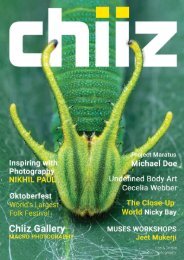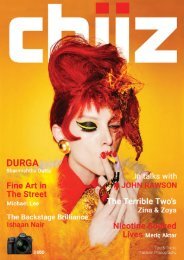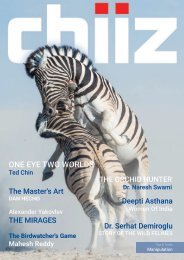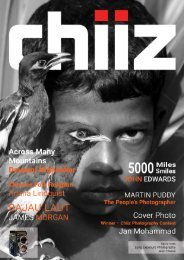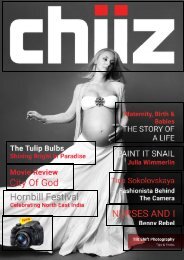Chiiz Volume 1 : Pushkar Photography
Chiiz is first of its kind publication devoted to descriptive Photography. Drawing on the requirements of a photo enthusiast, Chiiz features photographers and their unique and incisive stories from across the globe. With the EXIF details of every capture, we try to give the reader a perspective that helps him/her understand the shot better and recreate it. Photographers from around the world have been featured showcasing their outstanding work in different genres of photography.
Chiiz is first of its kind publication devoted to descriptive Photography. Drawing on the requirements of a photo enthusiast, Chiiz features photographers and their unique and incisive stories from across the globe. With the EXIF details of every capture, we try to give the reader a perspective that helps him/her understand the shot better and recreate it.
Photographers from around the world have been featured showcasing their outstanding work in different genres of photography.
Create successful ePaper yourself
Turn your PDF publications into a flip-book with our unique Google optimized e-Paper software.
OLD IS GOLD<br />
Prakhar Garg<br />
prakhar@chiiz.com<br />
Prakhar is always engrossed in his books<br />
and his diary. He believes in the saying ‘It<br />
Is What It Is.’ A wanderer by temperament,<br />
he wants to walk out on his story when the<br />
day comes.<br />
The Dali Atomicus, as this photograph is called,<br />
was captured by Philippe Halsman in 1948. The<br />
photograph is Halsman’s homage both to the new<br />
atomic age (prompted by physicist then-recent<br />
announcement that all matter hangs in a constant state<br />
of suspension) and to Dalí’s surrealist masterpiece<br />
“Leda Atomica” (seen on the right, behind the cats, and<br />
unfinished at the time).<br />
Capturing the essence of those he photographed was<br />
Philippe Halsman’s life’s work. So when Halsman set<br />
out to shoot his friend and longtime collaborator the<br />
Surrealist painter Salvador Dalí, he knew a simple seated<br />
portrait would not suffice. Inspired by Dalí’s painting<br />
Leda Atomica, Halsman created an elaborate scene<br />
to surround the artist that included the original work,<br />
a floating chair and an in-progress easel suspended<br />
by thin wires. Assistants, including Halsman’s wife<br />
and young daughter Irene, stood out of the frame and,<br />
on the photographer’s count, threw three cats and a<br />
bucket of water into the air while Dalí leaped up. It took<br />
the assembled cast 28 takes to capture a composition<br />
that satisfied Halsman. The final result, published in<br />
LIFE, evokes Dalí’s own work. Dali not only played the<br />
role of a protagonist in the photograph but he also<br />
painted on it. Philippe cut it out and collage it in.<br />
Philippe Halsman, The Legendary Photographer<br />
But before settling on the “Atomicus” we know today,<br />
Halsman rejected a number of other concepts for the<br />
shot. One was the idea of throwing milk instead of water,<br />
but that was abandoned for fear that viewers, fresh<br />
from the privations of World War II, would condemn<br />
it as a waste of milk. Another involved exploding a<br />
duck in order to capture it “in suspension,” though that<br />
arguably would have been a waste of ducks.<br />
Halsman’s approach, to bring subjects such as Albert<br />
Einstein, Marilyn Monroe and Alfred Hitchcock into<br />
sharp focus as they moved before the camera, redefined<br />
portrait photography and inspired generations of<br />
photographers to collaborate with their subjects.<br />
As Halsman wrote in his book ‘Halsman on the<br />
Creation of Photographic Ideas’, “Six hours and twentyeight<br />
throws later, the result satisfied my striving for<br />
perfection. (…) My assistants and I were wet, dirty, and<br />
near complete exhaustion—only the cats still looked<br />
like new”.<br />
On the next page(Below), you can see a retouched<br />
version of the photograph that was published in<br />
LIFE magazine. And in the photo above it, the wires<br />
suspending the easel and the painting, the hand of the<br />
Philippe’s wife holding the chair and the prop holding<br />
up the footstool can still be seen. The frame on the<br />
easel is still empty.<br />
Halsman’s methods were as unique as they were<br />
effective. His portraits appeared on 101 LIFE magazine<br />
covers(most by any person so far) including 7 of his<br />
66 Vol.1






